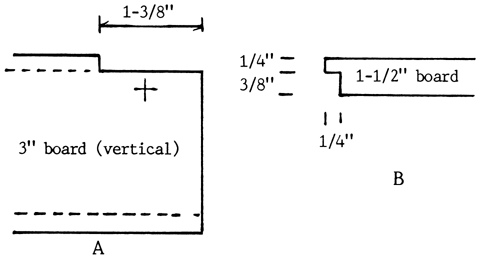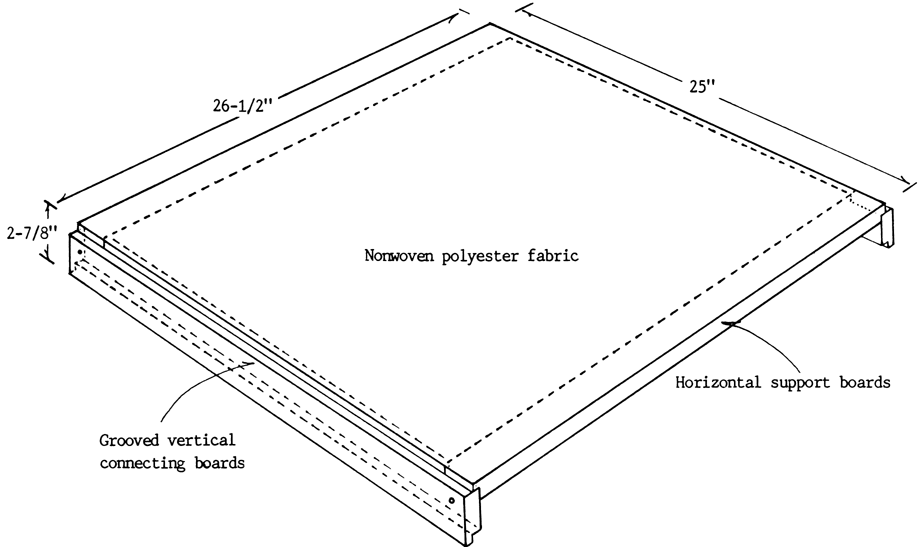

The following is a simple and inexpensive design for the construction of self-stacking drying racks for book and paper conservation. The frames I had fabricated by a local carpenter--the support material I attached myself. This design has further advantages: 1) the use of a non-textured support material (polyester fabric) eliminates tide marks. 2) Portability. 3) the size can be customized to accommodate purpose and storage space. 4) More racks cam be added at any time.
Frames: 3" x 3/4" hardwood board 1½" x 3/4" hardwood
(Note that board dimensions in illustrations are actual finished size.)
Wood glue
1¼" wood screwsSupport: Nonwoven polyester web (Reemay)1 Adhesive web (Archivart Adhesive Web) 2 PVA
A table saw with an accurate size gauge and an adjustable height blade. Drill, screwdriver, clamps, and a household iron.

Fig. 1. 3" board detail (end view)
Construction of frames. (Overall rack size may be varied; a rack 25" x 26½" is described.) the 3" board is cut to 25" lengths, two per rack. The grooves are made (Fig. 1) using the side gauge and the adjustable height blade on the table saw. These can all be made with two adjustments of the table saw. This shape forms the connecting parts of the racks. The 1½" board is cut to 26½" lengths, two per rack. A ¼" by 3/8" notch is sawn from both ends of these pieces (Fig. 2B). A 1-3/8" section of the top ½" edge is removed from both ends of the 3" boards (Fig. 2A) to allow the 1½" boards to join smoothly at 90° (Fig. 3), leaving a flush surface at the top of the rack frame. Glue the pieces together to form frames and clamp until dry. Pre-drill and drive in the wood screws where shown (Fig. 3). If done accurately, these frames will stack easily on top of one another. The frames may be sanded and sealed, rubbed with linseed or tung oil, or otherwise finished.
Attachment of support. Cut pieces of nonwoven polyester fabric oversize, to extend past the outer edges of the frame.

Fig. 2. Cutouts to form joint (side view)

Fig. 3. Detail of joint structure
Cut the adhesive web into 3/4" and 1/4" strips. Use the 3/4" strips on the horizontal support boards (Fig. 4). Using dots of PVA, attach the strips to the top surface of the frame, adhesive side up. the strips should be flush with the outer edges of the frame. Carefully position polyester into place (use a yardstick across the frame to temporarily hold up the polyester). Using a regular household iron at the temperature recommended for the adhesive web used (or experiment to find the best temperature), firmly attach one edge, allowing excess to extend over. Keeping the polyester held taut but even, carefully attach it with the iron halfway up one side, then halfway up the other side. Now complete the attachment by holding it taut by first one then the other of the unattached corners. This becomes easier after the first one. You can also attach it by spots at first (making it easier to lift if it is poorly positioned), and then go back over it to complete the seal. After it is finished, trim off the excess web by using a sanding board or block against the outside corners of the edges.
This design allows about 2" daylight between racks at two sides. Cut-outs may be incorporated in the connecting sides for additional ventilation, but I have not found this necessary, and it could be detrimental to the overall stability. Also, a fan may be placed advantageously to increase the air movement and reduce the drying time.

Fig. 4.
1. Reemay is a brand name, available from University Products, Inc., South Canal St., PO Box 101, Holyoke, MA 01041.
2. Adhesive web is available from Process Materials Corp., 301 Veterans Blvd., Rutherford, NJ 07070. It may also be worthwhile experimenting with applications of heat-sensitive PVA or acrylic resins to make your own adhesive web. After drying, the adhesive can be activated with an iron as described for the commercial web above.